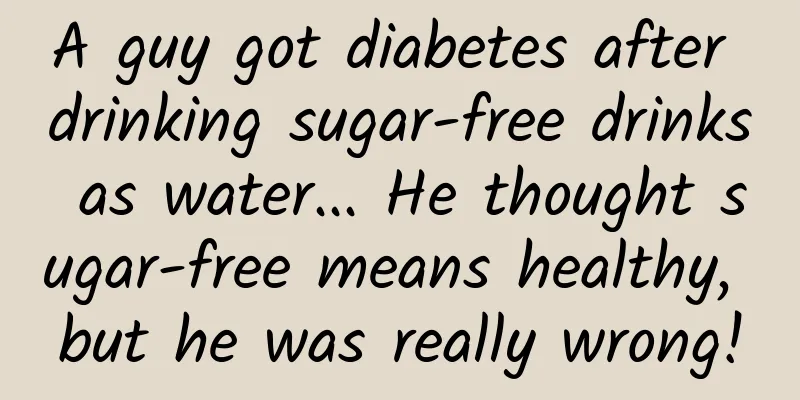A guy got diabetes after drinking sugar-free drinks as water... He thought sugar-free means healthy, but he was really wrong!

|
There was a report not long ago that a young man in Hubei drank large amounts of sugar-free beverages for a long time. He wanted to control his blood sugar levels for a healthy way, but he didn't expect it to backfire and he developed type 2 diabetes because of the "sugar-free" drink. According to the doctor, the reason why this young man got sick was that the excessive intake of sweeteners in sugar-free drinks led to insulin secretion disorders. At the same time, carbonated drinks also stimulated the gastrointestinal tract, causing intestinal flora disorders. Many young people believe that sugar-free drinks are healthy drinks that can reduce sugar intake and help control weight. So, does "sugar-free" really mean there is no sugar? Does no sugar mean health? The sweetness of sugar-free drinks depends on TA The sugar we often talk about is the sucrose, glucose, and white sugar listed in the ingredient list. Sugar-free beverages are actually a type of beverage that imitates the taste of traditional soda, and produces sweetness by adding artificial sweeteners such as sodium cyclamate, saccharin, or aspartame to replace sucrose and glucose. The sweetness of some artificial sweeteners is even higher than that of natural sugar. For example, the sweetness of aspartame is 200 times that of sucrose. Sweeteners are safe in themselves. They are easily soluble in water and very stable. They produce sweetness but hardly any energy. From this perspective, beverages with added sweeteners are less likely to make people fat than other high-sugar beverages. However, sweeteners are not nutrients and cannot be used by the human body. Excessive intake of sweeteners will also increase the burden on the body. Moreover, some sweeteners can produce an excitatory effect in the brain, which will lead people to consume other high-energy foods. Sugar-free also has health risks In addition to the influence of sweeteners, sugar-free carbonated drinks will have strong binding with metal ions, which may lead to osteoporosis; the drinks also contain a lot of caffeine; and some sugar-free foods, although no sugar is added, the starch itself can increase blood sugar... Therefore, sugar-free drinks and sugar-free foods still pose certain health risks to people. A 2014 Japanese study found that after excluding interfering factors such as family history, age and lifestyle factors, people who drank sugar-free beverages were more likely to develop diabetes than the blank control group. In 2012, a foreign study showed that sugar-free beverages would change the brain's feedback on sweetness through dopamine, causing a person to crave food more, especially sweets. The results showed that sugar-free beverages were not effective in reducing weight and even increased the risk of obesity. Recent studies have also found that in addition to increasing the prevalence of diabetes and obesity, sugar-free beverages also increase the incidence of cardiovascular and cerebrovascular diseases, affect liver function, and increase the prevalence of non-alcoholic fatty liver disease. A 2017 study showed that drinking one sugar-free beverage a day almost doubled the risk of stroke and Alzheimer's disease. Tips for Healthy Sugar Reduction On April 27 this year, the National Health Commission proposed to carry out the "Three Reductions and Three Healths" special action of reducing salt, oil and sugar, and maintaining healthy oral cavity, healthy weight and healthy bones during the "14th Five-Year Plan" period. It introduced several tips for reducing sugar: 1. Reduce the consumption of high-sugar packaged snacks Typical examples are biscuits, ice cream, chocolate, candy, cakes, candied fruit, jam, etc. If sugar is listed high on the ingredient list of the food packaging, it means that the sugar content is high. When buying, you should pay attention to check the food packaging. 2. Avoid or limit sugary drinks Choose tea, boiled water, and pure milk instead of sugary drinks. Sugary drinks are the main source of added sugar intake for children and adolescents. It is recommended not to drink or drink less sugary drinks. Use boiled water instead of drinks. It is recommended that infants and young children drink boiled water as the main drink. When making complementary foods, artificially added sugar should also be avoided. The best way for the human body to replenish water is to drink boiled water. 3. Tips on how to order food when dining out Sweet and sour spare ribs, sweet and sour pork, pot-fried pork, and fish-flavored shredded pork are all dishes with high sugar content, so try to order less or not at all. 4. Use sweet ingredients instead of added sugar For example, dates, yam, honey, carrots, pumpkin, potatoes, etc. Author: Xiao Misu, Chief Pharmacist, Shanghai Sixth People's Hospital Affiliated to Shanghai Jiao Tong University Review expert: Zhang Jianping, deputy chief pharmacist of the Sixth People's Hospital affiliated to Shanghai Jiaotong University |
<<: HPV vaccine is free in Jiangsu! Here are some things you need to know about HPV
Recommend
When planning creative information flow advertising, you must pay attention to these four details!
When placing homogeneous advertisements in inform...
How to write an integrated marketing communication case?
Last year, I wrote an article titled "How to...
How does Baijiahao make money? Teach you how to quickly become a regular account and start benefiting?
Everyone should know that with the rapid developm...
APP operation: How to quickly acquire and retain users?
Nowadays, the demographic dividend is getting sma...
Chinese Valentine's Day short video advertising marketing promotion!
That’s right, the annual Dog Abuse Festival is co...
Summary of unknown black hat SEO techniques
For website optimization SEO personnel, it is not...
How to keep your programmers from getting bored with their work?
As a programmer, I never worked for the same comp...
Li Xingxing: Practical Editing Training Camp
Li Xingxing: Editing Practice Training Camp Resou...
June 2023 "Science" Rumor List: Is heat stroke the same as heat stroke? Can mineral water exposed to the sun in a car cause cancer?
The list of "scientific" rumors for Jun...
Sparking heated discussion: Can microplastics in takeout really invade the brain within two hours?
Previously, the topic #Microplastics in takeout c...
Information flow delivery | Core analysis of conversion bidding!
Conversion bidding is the core of information flo...
Why are instant noodles curly? Because there is a reason for them to be curly
Instant noodles are the most common but indispens...
4 hours before sinking, the Titanic responded to the iceberg warning like this...
"CQD SOS 11.50pm from MGY. We have hit an ic...
This insect likes to hold blind date meetings right above your head!
Some time ago, chironomids were in the news again...









